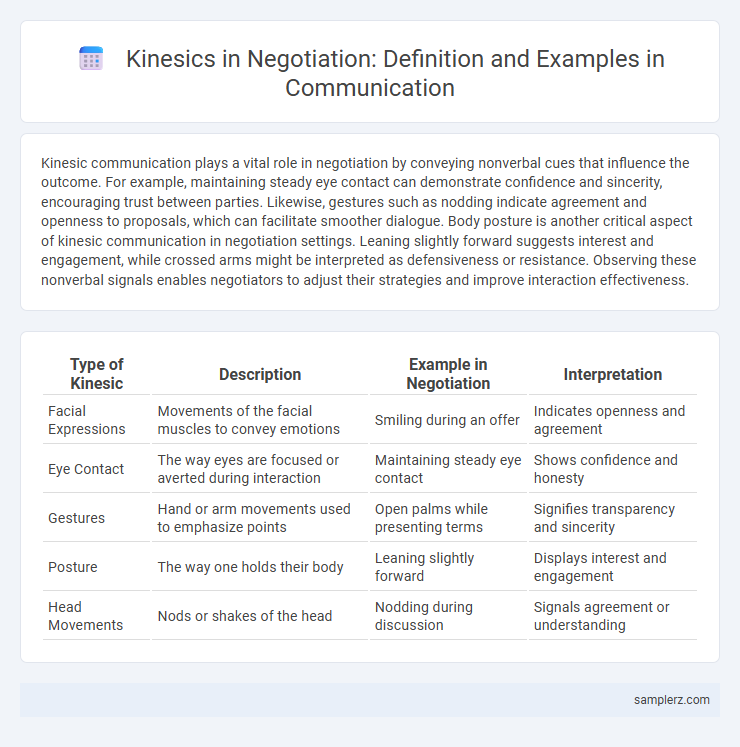Kinesic communication plays a vital role in negotiation by conveying nonverbal cues that influence the outcome. For example, maintaining steady eye contact can demonstrate confidence and sincerity, encouraging trust between parties. Likewise, gestures such as nodding indicate agreement and openness to proposals, which can facilitate smoother dialogue. Body posture is another critical aspect of kinesic communication in negotiation settings. Leaning slightly forward suggests interest and engagement, while crossed arms might be interpreted as defensiveness or resistance. Observing these nonverbal signals enables negotiators to adjust their strategies and improve interaction effectiveness.
Table of Comparison
| Type of Kinesic | Description | Example in Negotiation | Interpretation |
|---|---|---|---|
| Facial Expressions | Movements of the facial muscles to convey emotions | Smiling during an offer | Indicates openness and agreement |
| Eye Contact | The way eyes are focused or averted during interaction | Maintaining steady eye contact | Shows confidence and honesty |
| Gestures | Hand or arm movements used to emphasize points | Open palms while presenting terms | Signifies transparency and sincerity |
| Posture | The way one holds their body | Leaning slightly forward | Displays interest and engagement |
| Head Movements | Nods or shakes of the head | Nodding during discussion | Signals agreement or understanding |
Understanding Kinesics: The Role of Body Language in Negotiation
In negotiation, kinesics plays a crucial role as subtle gestures such as nodding, maintaining eye contact, and open hand movements signal agreement, confidence, and trustworthiness. Recognizing crossed arms or lack of eye contact can indicate resistance or doubt, enabling negotiators to adjust their approach. Mastery of body language enhances communication effectiveness by revealing unspoken attitudes, improving rapport, and facilitating mutually beneficial agreements.
Facial Expressions: Decoding Emotions at the Negotiation Table
Facial expressions play a crucial role in negotiation as they reveal underlying emotions and intentions, enabling negotiators to gauge trustworthiness and openness. Microexpressions, such as fleeting smiles or subtle frowns, can indicate agreement or hesitation beyond spoken words. Recognizing these nonverbal cues enhances rapport-building and strategic decision-making during complex bargaining processes.
Eye Contact: Building Trust and Credibility
Sustained eye contact during negotiation signals confidence and fosters trust between parties. It enhances credibility by demonstrating attentiveness and sincerity, encouraging openness and cooperation. Avoiding eye contact may be perceived as evasiveness, undermining the negotiation's effectiveness.
Gestures: Conveying Confidence or Uncertainty
Firm handshakes and steady eye contact during negotiation convey confidence, signaling assertiveness and control. Conversely, fidgeting, avoiding eye contact, or crossed arms often reveal uncertainty or discomfort, undermining persuasive efforts. Clear and purposeful gestures enhance message clarity and influence negotiation outcomes effectively.
Posture: Projecting Authority and Openness
Maintaining an upright posture with shoulders back and chest open during negotiation signals confidence and authority, encouraging trust and respect from counterparts. A balanced stance with relaxed arms and hands visible demonstrates openness and receptivity, fostering transparent communication. Effective use of posture enhances influence and builds rapport, crucial for successful negotiation outcomes.
Handshakes: The First Impression in Negotiations
Handshakes serve as a crucial kinesic element in negotiation, often conveying confidence, openness, and respect before verbal communication begins. A firm, well-timed handshake can establish trust and set a positive tone, influencing perceptions of professionalism and sincerity. Variations in grip strength and duration subtly communicate power dynamics and willingness to cooperate.
Mirroring Movements: Establishing Rapport with Counterparts
Mirroring movements in negotiation involves subtly imitating the body language and gestures of counterparts to establish rapport and trust. This kinesic technique enhances nonverbal communication by creating subconscious connections that facilitate mutual understanding and cooperation. Effective mirroring helps negotiators build positive relationships, increase empathy, and improve the overall success of the negotiation process.
Proxemics: The Impact of Personal Space in Negotiations
Proxemics plays a critical role in negotiations by influencing comfort levels and signaling intentions through personal space management. Maintaining appropriate distance, typically between 18 inches to 4 feet, fosters trust and openness, while invading personal space can provoke discomfort or defensiveness. Effective negotiators read these spatial cues to adjust their proximity, facilitating smoother communication and enhancing the likelihood of successful agreements.
Microexpressions: Spotting Hidden Feelings
Microexpressions, fleeting facial expressions lasting only fractions of a second, reveal genuine emotions that negotiators may try to conceal. Recognizing these subtle cues like brief flashes of fear, contempt, or happiness allows negotiators to detect hidden feelings and underlying intentions, enhancing their strategic responses. Mastery of kinesics in negotiation involves accurately interpreting microexpressions to gain an advantage by uncovering unspoken hesitations or deceptions.
Cultural Variations in Kinesics During Negotiation
Cultural variations in kinesics significantly impact negotiation outcomes, as gestures, facial expressions, and eye contact differ across societies. For example, direct eye contact is seen as confidence in Western cultures but can be perceived as confrontational in some Asian cultures. Understanding these nuances allows negotiators to interpret nonverbal cues accurately and adapt their communication styles to build trust and facilitate agreement.

example of kinesic in negotiation Infographic
 samplerz.com
samplerz.com